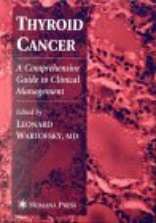|
|
|
| |
 |
|
|

|
 推薦指數:
推薦指數:





|
|
- 內容介紹
|
Thyroid Cancer: A Comprehensive Guide to Clinical Management
by L. Wartofsky (Editor), Ernest L. Mazzaferri
Hardcover - 515 pages 1st edition (January 15, 2000)
Humana Press; ISBN: 0896034291 ; Dimensions (in inches): 1.31 x 10.28 x 7.30
From The New England Journal of Medicine, April 27, 2000
Thyroid cancer, an uncommon disease, accounts for only about 1 percent of new cancers diagnosed each year. In contrast, benign thyroid nodules are common, with 5 to 10 percent of women having one or more palpable lumps in the thyroid. The challenge facing the clinician is therefore to distinguish the small proportion of patients with thyroid cancer from the larger number with benign, nodular enlargement of the gland. Opinions differ widely as to how best (and most cost effectively) to examine patients with thyroid enlargement in whom the diagnosis of thyroid cancer is a possibility. Once the diagnosis of thyroid cancer has been made, the next challenge is to determine the optimal approach to treatment to improve the prognosis in what is usually, in the case of differentiated thyroid cancer, a forgiving and relatively "benign" disease. Because of the rarity of thyroid cancer and its typically good prognosis, there have been no prospective studies of treatment options for the common forms of the disease. This, in turn, means that there is debate about the optimal use of surgery and radioiodine to treat differentiated thyroid tumors as well as about the most appropriate means of follow-up to detect recurrent or residual disease.
These controversies are highlighted in Thyroid Cancer: A Comprehensive Guide to Clinical Management. The book brings together the views of experts (many from the Washington, D.C., area) in a wide range of specialties involved in the treatment of patients with thyroid cancer. The book does not attempt to reach a consensus regarding some of the debated issues, and conflicting opinions are appropriately expressed. Relatively little space is devoted to the assessment of patients with one or more thyroid nodules, although the use of fine-needle aspiration to obtain specimens for cytologic examination clearly emerges as the first step. More coverage of the debate on this topic would have been useful, since a "lump in the thyroid" is such a common clinical problem and is managed in a variety of clinical settings. What is surprising is that suppressive therapy with thyroxine appears in the diagnostic workup in the first figure in the book, even though evidence of its lack of specificity and sensitivity is presented in the text. Clearly, this is a question that will benefit from more detailed cost-benefit analysis.
|
|
|

